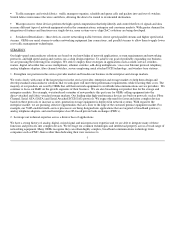Adaptec 2004 Annual Report Download - page 14
Download and view the complete annual report
Please find page 14 of the 2004 Adaptec annual report below. You can navigate through the pages in the report by either clicking on the pages listed below, or by using the keyword search tool below to find specific information within the annual report.
products from Chartered Semiconductor Manufacturing Ltd. (“Chartered”), and Taiwan Semiconductor Manufacturing Corporation
(“TSMC”). These independent foundries produce the wafers for our networking products at feature sizes down to 0.13 micron. By
using independent foundries to fabricate our wafers, we are better able to concentrate our resources on designing, development and
testing of new products. In addition, we avoid the fixed costs associated with owning and operating fabrication and chip assembly
facilities, and the costs associated with updating these facilities to manage constantly evolving process technologies.
We have supply agreements with both Chartered and TSMC that were renewed through December 31, 2005. As a result of these
renewals, the deposits we have made to secure access to wafer fabrication capacity decreased subsequent to December 31, 2004 to
$5.1 million. Under these agreements, the foundries must supply certain quantities of wafers per year. Neither of these agreements
have minimum unit volume requirements but we are obliged under one of the agreements to purchase a minimum percentage of our
total annual wafer requirements provided that the foundry is able to continue to offer competitive technology, pricing, quality and
delivery. These agreements may be terminated at any time if either party violates the terms of the agreements. We do not currently
anticipate any problems in renewing these supply agreements beyond the current expiry dates.
Assembly and Test
Once our wafers are fabricated, they must be probed, or inspected, to identify which individual units, referred to as die, were properly
manufactured. Most wafers that we purchase are sent directly to an outside assembly house where the die are individually cut and
packaged into semiconductor devices. The individual devices are then run through various electrical, mechanical and visual tests
before customer delivery. With most of our products, we have the option to probe the wafers or test the final chips in−house or
subcontract the probing or testing to independent subcontractors.
Quality Assurance
The industries that we serve require high quality, reliable semiconductors for incorporation into their equipment. We pre−qualify each
vendor, foundry, assembly and test subcontractor. Wafers supplied by outside foundries must meet our incoming quality and test
standards. We conduct a portion of our test operations on advanced mixed signal and digital test equipment in our Burnaby facility.
The remainder of our testing is performed predominantly by independent U.S. and Asian companies.
RESEARCH AND DEVELOPMENT
Our research and development efforts are market and customer−focused and often involve the development of both hardware and
software. These devices, commonly referred to as systems−on−a−chip (SoCs), are targeted for use in enterprise, storage and service
provider markets. Increasingly, our OEM customers that serve these end markets are demanding complete solutions with software
support and complex feature sets.
From time to time we announce new products to the public once development of the product is substantially completed, and there are
no longer significant costs to be incurred. As we have a
10
























